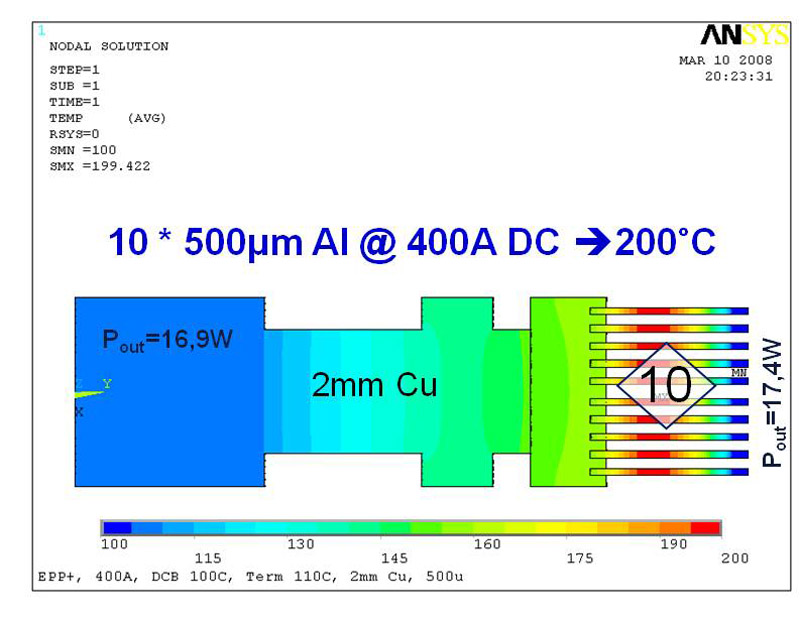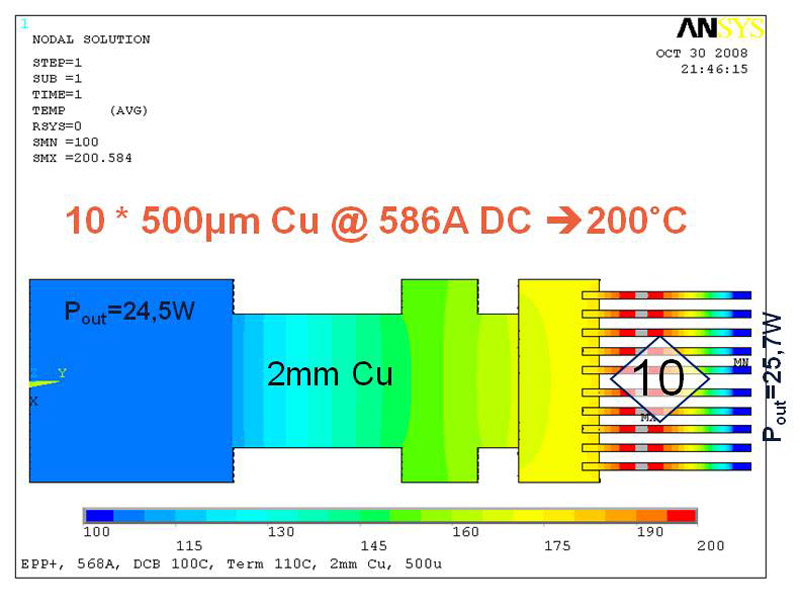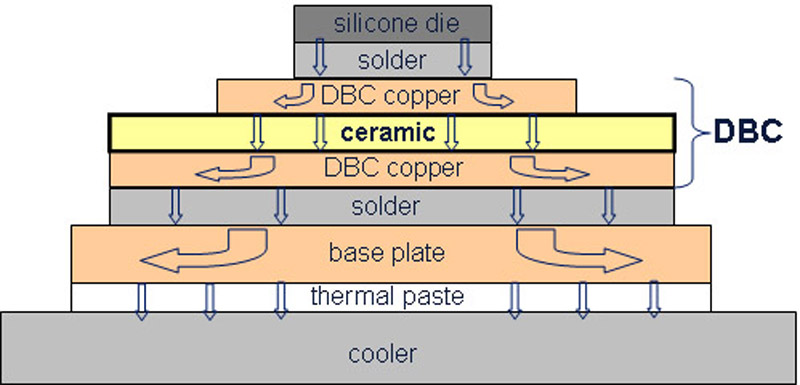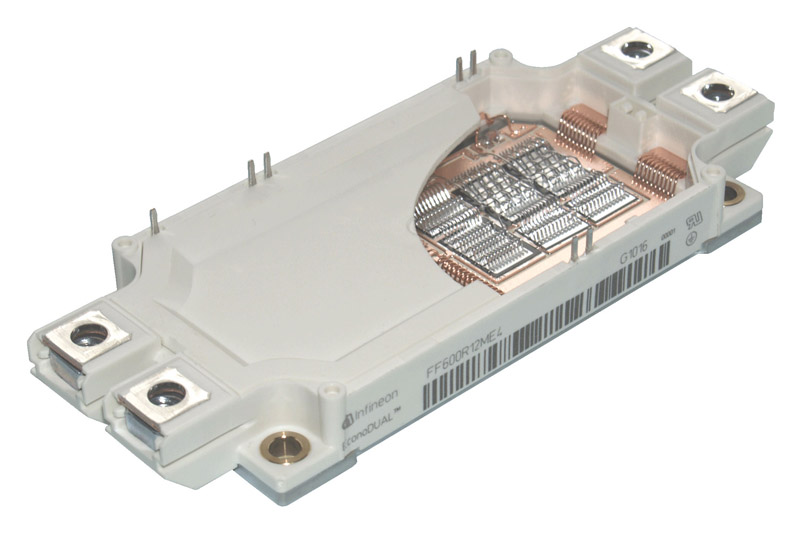Author:
Martin Knecht, Roman Tschirbs & Roland Ott, Infineon Technologies AG
Date
05/26/2011
Power module development is striving for higher power densities, not only in new but also in already established packages. Two main challenges for such kinds of upgrades are to meet the increased requirements towards ampacity and heat dissipation. These requirements may enforce adjustments in the utilized packaging technologies to overcome the given package limitations The continuous trend of IGBT chip optimization enables IGBT power module development to increase the power density in their packages from IGBT generation to IGBT generation. For example, the nominal current rating of Infineon 62mm half-bridge modules was increased continuously over the different IGBT generations from IGBT 1st generation (Inom = 150A) to IGBT 4th generation (Inom = 450A) by a factor of three. This increased power density is doubtlessly beneficial especially for the design of more and more compact inverters and therefore more than welcomed by the IGBT power module market. In particular, there is a strong demand for increased power densities in already well established IGBT power module packages, as it offers the inverter designers the opportunity not only to integrate such packages into newly developed inverters, but also to upgrade existing inverter designs to higher output powers without changing the mechanical set-up. However, handling of the increased power densities in a given module package might be limited by several boundary conditions, as inverter cooling conditions and maximum system temperatures. But also from the IGBT module's point of view, measures might have to be taken to assure that the current rating offered by the implemented silicone dies can be fully utilized in the real application. Most probably, the two most relevant parameters of a given IGBT power module package will be • the ampacity / conductivity and • the thermal resistivity.

Ampacity / Conductivity Currently established modules like the EconoPACK™+ or the EconoDUAL™3 use Aluminium bond wires for contacting the power connections, the conductor pathes and the silicon dies. Fig.1 shows the Al bond wire connections of the EconoDUAL™3 package as an example. However, with future increased current ratings, this well established interconnection technology may come, in certain cases, to its limits. For newly developed power module packages, the implementation of ultrasonic welding connections proofs to be a smart and reliable solution to overcome possible ampacity limits, but staying with existing module package lay-outs may require other adaptable solutions. As copper wire bonding was recently introduced as a new alternative contact technology and reveals several significant advantages over Aluminium bond wires, the idea suggests itself to investigate this technology as a possible candidate for the interconnections from DBC to DBC and from DBC to the power terminals as well. A general comparison of the relevant material properties of both Copper and Aluminium (as shown in Tab.1) reveals a decreased thermal resistivity, an increased thermal conductivity and a higher melting temperature of the Copper bonds, promising higher ampacities at similar boundary conditions. Selection of relevant material properties of Copper and Aluminium Electrical resistivity Copper: 1.7μOhm*cm Aluminum: 2.7μOhm*cm Thermal Conductivity Copper: 400 W/m*K Aluminum: 220 W/m*K CTE Copper: 16.5 ppm Aluminum: 25 ppm Yield Strength Copper: ?140MPa Aluminum: ?29MPa Elastic Modulus Copper: 110-140GPa Aluminum: ~50GPa Melting Temperature Copper: ~1083°C Aluminum: ~660°C Numerical simulations (Fig.2 and Fig.3) illustrate the electro-thermal advantages of the copper bond wires over the Aluminum bonds in more detail: At similar boundary conditions, the ampacity of a chosen standard set-up with 10 bond wires of each 500μm thickness was increased by a factor of ~1.5 from 400A to almost 600A dc collector current. This result makes copper bond wires an ideal candidate for the substitution of aluminium bond wires in existing IGBT module packages, whenever an increased ampacity is required.

Thermal resistivity Increasing the power density in a given package might lead to a higher power dissipation density, being not only a challenge for the cooling system of the inverter, but also for all thermal interfaces inside the module. In general, the thermal resistivity Rth of a specific material is determined by the thickness (s), the thermally active area (A) and the thermal conductivity:


Following this equation, it can be concluded that a reduction of the thermal resistance of a layer inside a power module system can be achieved by • reducing its thickness s, • increasing its thermal conductivity l or • increasing its thermally active area A by improved heat spreading in previous layers. Fig.4 Heat flow and spreading in a state-of-the-art IGBT power module with base plate. The DBC parts are highlighted. Fig.4 shows the schematic of heat flow and spreading in a state-of-the-art IGBT power module with base plate. At a given set-up, the layers to be particularly optimized are the DBC copper and DBC ceramic layers, e.g. by • increasing the DBC conducting layer thickness for improved conductivity and heat spreading, • increasing the thermal conductivity l of the DBC ceramic layer or • reducing the DBC ceramic layer thickness.

Transfer to a real product EconoDUAL™3 Based on the previous considerations, the development of a new EconoDUAL™3 module has been started. The development target was not only to achieve a nominal current rating of 600A in the 1200V blocking voltage class by the implementation of the latest IGBT 4th generation dies, but also to provide a real increase of the achievable RMS output current of the inverter, compared to the already existing FF450R12ME4 EconoDUAL™3. For the realization of this target, copper bond wires were implemented for the interconnections of the copper conductor paths on the DBCs as well as for the connections to the power terminals (see Fig.5). Furthermore, the DBC was thermally optimized by a combination of several appropriate measures as described, improving heat spreading and thermal resistance of the package. To evaluate the adequateness of the implemented new technologies, an exemplary calculation of the EconoDUAL™3 with FF450R12ME4 is compared with the new FF600R12ME4 utilizing all presented new assembly technologies. The calculation proofs that the proposed measures are effective: The achievable RMS output current is increased by up to 30%, fully utilizing the implemented new IGBT 4th generation dies with increased current rating. Summary In this article, it is proven that established IGBT power module packages can be toughened up for significantly higher power densities by consequent implementation of new, beneficial assembly technologies. This is also demonstrated by means of a newly developed half-bridge module in the well established EconoDUAL™3 housing that provides, in combination with Infineon's latest 4th generation IGBTs, up to 30% more output power. Offering higher power densities in established module packages includes the advantage to upgrade existing inverter designs to higher output powers without changing the mechanical set-up. www.infineon.com